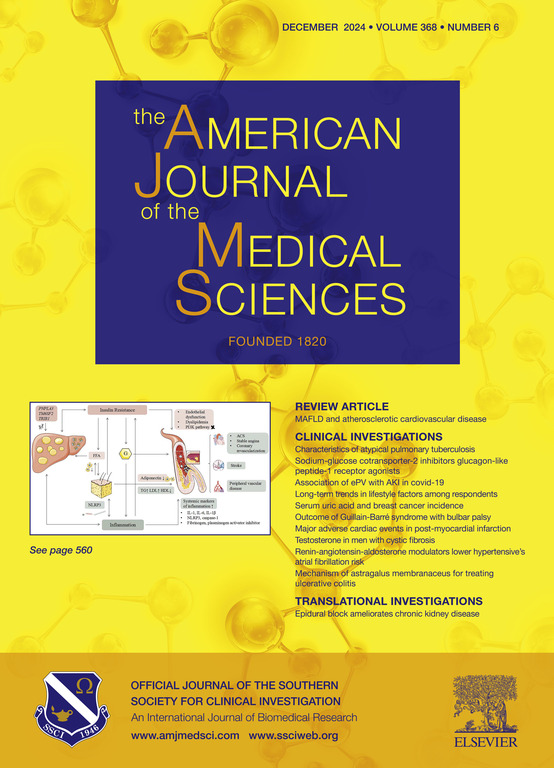Presence of chronic complications differentiates in-hospital outcomes of transjugular intrahepatic portosystemic shunt in patients with diabetes mellitus
IF 1.8
4区 医学
Q2 MEDICINE, GENERAL & INTERNAL
引用次数: 0
Abstract
Background
Transjugular intrahepatic portosystemic shunt (TIPS) is an interventional radiological procedure to reduce portal hypertension. Hyperglycemic state in diabetes mellitus (DM) is associated with vascular injuries that can lead to chronic complications, which is implicative of the extent/control of DM. This study aimed to use chronic complications as a marker for uncontrolled DM and examine major in-hospital outcomes after TIPS among DM patients with (DM-WCC) and without chronic complications (DM-WOCC).
Materials
Patients who underwent TIPS were identified in the National Inpatient Sample (NIS) from Q4 2015–2020. DM-WCC and DM-WOCC were identified using the Elixhauser comorbidity measure. In-hospital post-TIPS outcomes between DM-WCC, DM-WOCC, and non-DM patients were compared using multivariable logistic regression.
Results
NIS identified 1199 DM-WOCC, 1229 DM-WCC, and 4230 non-DM. Compared to non-DM, DM-WOCC had lower in-hospital mortality (aOR=0.661, 95 CI=0.493–0.885, p = 0.01) and renal complications (aOR=0.632, 95 CI=0.534–0.749, p < 0.01). Compared to non-DM, DM-WCC had higher renal complications (aOR=1.366, 95 CI=1.174–1.591, p < 0.01) and hepatic encephalopathy (HE; aOR=1.378, 95 CI=1.189–1.597, p < 0.01). Compared to DM-WOCC, DM-WCC had higher mortality (aOR=1.452, 95 CI=1.025–2.057, p = 0.04), renal complications (aOR=2.165, 95 CI=1.774–2.641, p < 0.01), and HE (aOR=1.247, 95 CI=1.045–1.487, p = 0.01). DM-WOCC had shorter length of stay and less total hospital costs than both DM-WCC and non-DM.
Conclusions
The presence of chronic complications in DM may differentiate the risk of complications after TIPS, where DM-WCC patients had worse outcomes, while DM-WOCC seems to be protective. Managing diabetic chronic complications may be helpful to avoid adverse outcomes after TIPS.
慢性并发症的存在区分糖尿病患者经颈静脉肝内门静脉分流术的住院结果。
背景:经颈静脉肝内门静脉系统分流术(TIPS)是一种降低门静脉高压症的介入放射治疗方法。糖尿病(DM)的高血糖状态与血管损伤相关,可导致慢性并发症,这与糖尿病的程度/控制有关。本研究旨在将慢性并发症作为糖尿病未控制的标志,并检查伴有(DM- wcc)和无慢性并发症(DM- wocc)的糖尿病患者在TIPS后的主要住院结果。材料:在2015-2020年第四季度的国家住院患者样本(NIS)中确定了接受TIPS的患者。DM-WCC和DM-WOCC采用Elixhauser合并症量表进行鉴定。采用多变量logistic回归对DM-WCC、DM-WOCC和非dm患者的tips后住院结果进行比较。结果:NIS共鉴定DM-WOCC 1199个,DM-WCC 1229个,非dm 4230个。与非糖尿病患者相比,DM- wocc患者的住院死亡率(aOR=0.661, 95 CI=0.493-0.885, p=0.01)和肾脏并发症(aOR=0.632, 95 CI=0.534-0.749, p)较低。结论:慢性并发症的存在可以区分TIPS术后并发症的风险,DM- wcc患者预后较差,而DM- wocc似乎具有保护作用。控制糖尿病慢性并发症可能有助于避免TIPS后的不良后果。
本文章由计算机程序翻译,如有差异,请以英文原文为准。
求助全文
约1分钟内获得全文
求助全文
来源期刊
CiteScore
4.40
自引率
0.00%
发文量
303
审稿时长
1.5 months
期刊介绍:
The American Journal of The Medical Sciences (AJMS), founded in 1820, is the 2nd oldest medical journal in the United States. The AJMS is the official journal of the Southern Society for Clinical Investigation (SSCI). The SSCI is dedicated to the advancement of medical research and the exchange of knowledge, information and ideas. Its members are committed to mentoring future generations of medical investigators and promoting careers in academic medicine. The AJMS publishes, on a monthly basis, peer-reviewed articles in the field of internal medicine and its subspecialties, which include:
Original clinical and basic science investigations
Review articles
Online Images in the Medical Sciences
Special Features Include:
Patient-Centered Focused Reviews
History of Medicine
The Science of Medical Education.

 求助内容:
求助内容: 应助结果提醒方式:
应助结果提醒方式:


